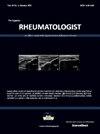Evaluation of functional measures and laboratory parameters to portend limitations of spinal mobility in patients with radiographic axial spondyloarthritis
IF 1
Q4 RHEUMATOLOGY
引用次数: 0
Abstract
Aim of the work
To specify clinical and laboratory parameters related to limited spinal mobility in radiographic axial spondyloarthritis (r-axSpA) patients.
Patients and methods
The study included 202 adult r-axSpA patients. Clinical characteristics, medications, investigations including serum C-reactive protein (CRP) and human leukocytic antigen-B27 positivity were noted. Lateral lumbar flexion (LLF), chest expansion (CE) and tragus-to-wall distance (TWD) were measured. Values <2.5 percentile in LLF, CE and TWD were noted as reduced mobility of lumbar, thoracic and cervical spine, respectively.
Results
The median age of patients was 43 years, male:female was 3.7:1. The time to diagnosis was 7.5 (3–40) years and were followed-up for 7.2 (4–22) years. Disease duration and high baseline CRP (>10 mg/L) were critical risk factors for reduced spinal mobility (p = 0.001 and p < 0.01). The duration to impaired LLF was significantly shorter in smokers (n = 105) (10.3;0–30.5 years) vs non-smokers (15.2;4.5–35 years) (p = 0.001) and in those with positive family history (n = 50) (9.7;0–20 years) compared to those without (12.9;4–35 years) (p = 0.09). LLF, CE and TWD were impaired in 40 % vs 75 %, 10 % vs 55 % and 12 % vs 60 % of patients with symptom duration of 10 vs 30 years respectively. Those with delayed introduction of biologics had significantly more impaired LLF, CE and TWD: 10.1(2–25) vs 14(3–33) years; 10.4(3–26) vs 17.5(8–33) years; 10.7(3–27) vs 16.7(5–33) years; p = 0.001 for all, respectively).
Conclusions
The most prominent factors affecting spinal mobility were the duration of symptoms and high serum CRP levels. The decreased spinal mobility was markedly less in patients with the early introduction of biologic therapy.
评估功能测试和实验室参数,预示放射性轴性脊柱关节炎患者脊柱活动度受限的情况
研究目的明确与放射性轴性脊柱关节炎(r-axSpA)患者脊柱活动受限有关的临床和实验室参数。研究记录了患者的临床特征、用药情况以及包括血清 C 反应蛋白(CRP)和人类白细胞抗原-B27 阳性在内的检查结果。测量了侧腰屈(LLF)、胸廓扩张(CE)和耳廓到墙壁的距离(TWD)。结果患者的中位年龄为 43 岁,男女比例为 3.7:1。确诊时间为 7.5(3-40)年,随访时间为 7.2(4-22)年。病程和高基线 CRP(10 毫克/升)是脊柱活动度降低的关键风险因素(p = 0.001 和 p <0.01)。吸烟者(n = 105)(10.3;0-30.5 年)与非吸烟者(15.2;4.5-35 年)相比(p = 0.001),以及有阳性家族史者(n = 50)(9.7;0-20 年)与无阳性家族史者(12.9;4-35 年)相比(p = 0.09),LLF 受损的持续时间明显较短。症状持续时间为 10 年和 30 年的患者中,LLF、CE 和 TWD 受损的比例分别为 40% 对 75%、10% 对 55% 和 12% 对 60%。延迟使用生物制剂的患者的LLF、CE和TWD受损程度明显更高:分别为10.1(2-25)年 vs 14(3-33)年;10.4(3-26)年 vs 17.5(8-33)年;10.7(3-27)年 vs 16.7(5-33)年;P = 0.001。结论:影响脊柱活动度的最主要因素是症状持续时间和高血清CRP水平。
本文章由计算机程序翻译,如有差异,请以英文原文为准。
求助全文
约1分钟内获得全文
求助全文

 求助内容:
求助内容: 应助结果提醒方式:
应助结果提醒方式:


